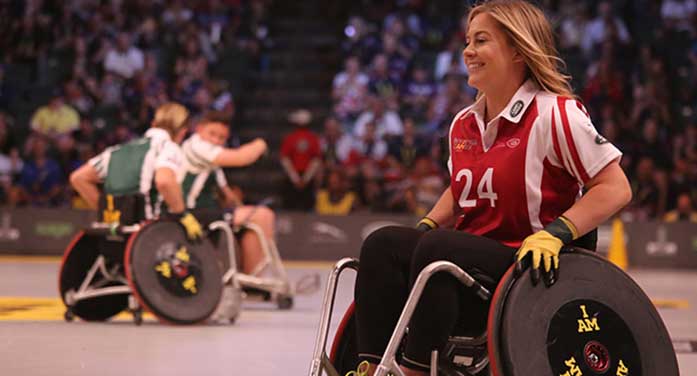The 2022 Winter Paralympics will shine a brief spotlight on Canada’s elite athletes in China over the next 10 days. But much more is needed at the community level to get athletes involved in parasport before they can even dream of competing at an elite level, according to former Paralympian Danielle Peers.
While changes are needed at the Paralympic level, such as how to diversify decision-making boards to include disability representatives, Peers said the more important conversation is how to eliminate barriers that prevent athletes from getting involved in parasport at all.
“My focus has been far more on how we start with problems lower down in the pyramid to ensure people have opportunities to participate,” said Peers, an associate professor in the Faculty of Kinesiology, Sport, and Recreation, who won a bronze medal in wheelchair basketball at the 2004 Paralympic Games in Athens.
“Any folks who want to cross over to that elite level can certainly do so, but we can’t allow their regulations and structures to determine who participates at a grassroots level.”
Some of these foundational changes would cost nothing and take hardly any time. In a 2020 study, Peers examined a wide variety of athletics websites and found the vast majority lacking in providing information about available programming for parasport and disabled athletes. Peers noted that simply having clear, easy-to-find information would reduce the barrier to participation.
Other small changes, such as making websites accessible for someone with a visual impairment, can also make a tremendous difference.
Another important factor, according to Peers, is making sure the messaging remains about sport. While many organizations have abundant information and representation of their athletic programming, for parasport, if there’s any information at all, it’s often “some ‘inspiration’ story or story of pity.”

Danielle Peers competes at the 2006 Wheelchair Basketball World Championship in Amsterdam, where Canada won gold and Peers was named World MVP. (Photo: Supplied)
“Why are we talking differently about these athletes than we talk about other athletes involved in the program?”
Another critical component is proper training for coaches, Peers said. For most elite athletes, having an integrated support team designed to bring out their peak performance is a given. Elite parasport athletes, however, are surprised if the coach who comes in to train them has any familiarity at all with the parasport they’ve been hired to coach.
“The number of times I’ve been coached by people who knew way less about the sport than I do – have never seen a wheelchair before but somehow believe they’re qualified to teach or coach wheelchair basketball at a national level – is astounding,” said Peers.
Making participation in sport accessible to everyone is critical at a societal level.
“A lot of our cultural ideas, our identities, our sense of belonging, can come through moving together,” said Peers, who also studies disability in relation to art and social justice movements.
“There’s just so many ways our culture revolves around these kinds of collective movement,” added Peers. Consequently, excluding individuals from participating in activities like sport essentially excludes them on a much wider level.
“The impacts of that are much more significant than I think we consider.”
| By Adriana MacPherson
Adrianna is a reporter with the University of Alberta’s Folio online magazine. The University of Alberta is a Troy Media Editorial Content Provider Partner.
The opinions expressed by our columnists and contributors are theirs alone and do not inherently or expressly reflect the views of our publication.
© Troy Media
Troy Media is an editorial content provider to media outlets and its own hosted community news outlets across Canada.


